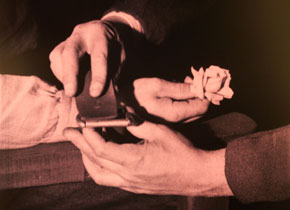http://www.stummfilm-silentmovie.de

The Whispering Chorus (1917)
Regie: Cecil B. DeMille; Drehbuch: Jeanie MacPherson, Perley Poore Sheehan; Kamera: Alvin Wyckoff; Darsteller: Raymond Hatton, Kathlyn Williams, Edythe Chapman, Gustav von Seyffertitz, Edna Mae Cooper. Farbkopie, ca. 92 min
In den Jahren unmittelbar nach seinem Debüt The Squaw Man (1914) betrat Cecil B. DeMille die amerikanische Filmszene als stilistischer Erneuerer: Die Kritik in Frankreich hatte The Cheat (1915) als Eckpfeiler des Kunstkinos gepriesen, und die auffällige Beleuchtungstechnik des Films (die sich primär dem Kameramann Alvin Wyckoff verdankte) war zu seiner visuellen Signatur geworden. Die stille Heldin in seiner Karriere ist aber Jeanie MacPherson, eine ehemalige Griffith-Schauspielerin und Autorin der meisten Stummfilme DeMilles. The Whispering Chorus, ihre brillante Bearbeitung einer Kurzgeschichte von Perley Poore Sheehan, ist praktisch ein Film noir - mit seiner krassen Schilderung eines ruchlosen Verbrechens und der folgenden Höllenfahrt in Richtung Schuld, doppelte Identität und tragische Erlösung. Psychoanalyse, Surrealismus und Sozialkritik verschmelzen in diesem kühnsten aller Werke von Cecil B. DeMille - dem meisterlichen Kino-Äquivalent eines Dostojewski-Romans. (PCU)
Am Klavier: Gerhard Gruber
In the years immediately following his 1914 début with The Squaw Man, Cecil B. DeMille entered the American filmmaking scene as a stylist and an innovator: The Cheat (1915) had been hailed by French critics as a cornerstone of cinema as art, and its lighting technique - largely due to cameraman Alvin Wyckoff - had become DeMille’s visual signature. The unsung hero of his career is Jeanie Macpherson, a former D.W. Griffith actress at Biograph and scriptwriter for the majority of DeMille’s films in the silent era. The Whispering Chorus, her brilliant adaptation from a short story by Perley Poore Sheehan, is virtually a film noir in its stark depiction of a heinous crime with the ensuing descent into guilt, double identity, and tragic redemption. Psychoanalysis, surrealism and social critique are merged in DeMille’s most audacious work ever, the masterful cinematic equivalent of a Dostoevsky novel. (PCU)